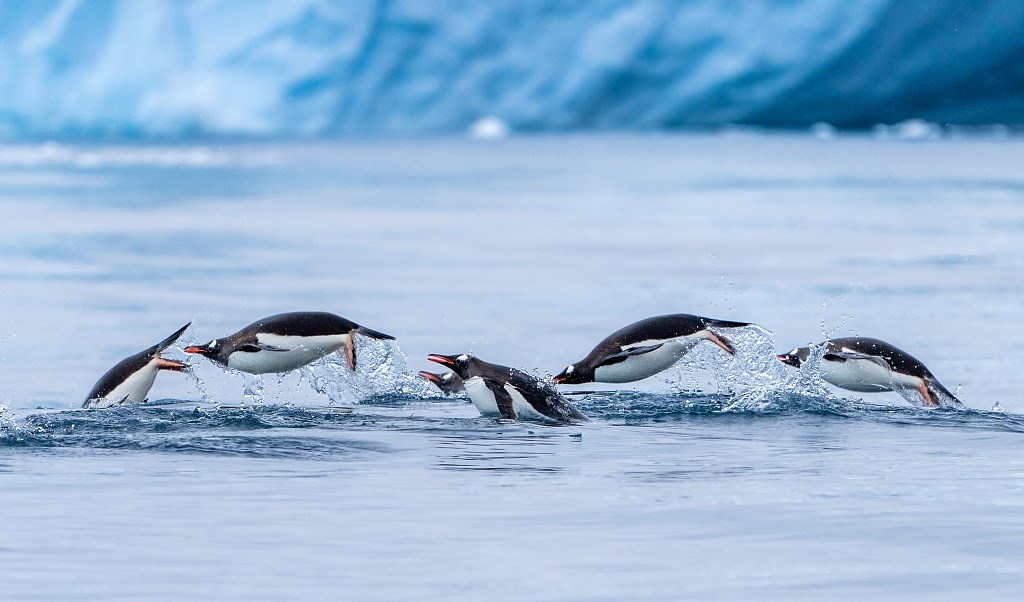Adélie penguin numbers off Antarctic coast declining 'rapidly'
Scientists believe that the significant decline is due to environmental changes.
-

Australian scientists monitor ‘rapid’ decline in Adélie penguin number. (VCG)
Australian scientists from the Australian Antarctic Division recorded a decline in the population of Adélie penguins off of the east Antarctic coast.
Scientists recorded a 43% drop over a decade in the number of birds that breed across 52 islands near the Mawson research station.
They said the decline is a stark contrast to other Adélie penguin populations in east Antarctica where numbers remain stable or show an increase. It also contradicts prior predictions that expected a steady increase in this population in previous decades.
In order to collect data, seabird ecologists studied, from 2010 to 2020, the islands along a 100-kilometer length of coastline to monitor breeding pairs. They discovered that the number of occupied nests decreased from 176,622 to 99,946, a decrease of approximately 77,000 nests or 154,000 breeding birds.
According to Louise Emmerson, a seabird biologist, the significant reduction in numbers is similar to that seen in Adélie populations on the Antarctic peninsula, where the effects of fishing, climate change, and other human activities have been most visible. The experts assume that a change in environmental conditions is to blame for the Mawson population's "rapid" drop.
— Al Mayadeen English (@MayadeenEnglish) June 15, 2022
Emmerson and co-author Colin Southwell wrote in Global Change Biology that the early declines were likely caused by a period of substantial summer "fast ice" - ice that is attached to land but covers seawater - from 2004-05 to 2009-10. They say this hampered access to foraging habitat resulting in virtually no chicks surviving in those years.
Although there has been an overall drop in fast ice in Antarctica, scientists have seen regional variability, with declines recorded in some areas and a rise detected in others. “Generally [the penguins] have to walk across the fast ice to open water to go foraging,” Emmerson said.
“Chicks are only 90 grams when they first hatch. They’re tiny things and at that stage, they require frequent small meals.” She claimed that because of the extensive fast ice, parents had to travel further for food and did not return as quickly or frequently as their chicks need.
As the frequency of poor breeding conditions increased, so did the number of fledglings surviving when they left the colony during the winter. “We think the reason this decline has been so rapid is there are two processes occurring: one on the breeding animals over the summer and the other on the population leaving the colony over winter,” she said.
“These two processes are feeding into each other, so as the population declined it has made the situation a whole lot worse for their survival.” The researchers estimate that in a strong mating season, the species had 80,000 fewer fledglings than it had in the early 2000s.
Read next: Climate change kills hundreds of penguins in New Zealand
According to Jane Younger, a lecturer at the University of Tasmania's Institute for Marine and Antarctic Studies, fledglings worked together to collect food as a team.
The penguins were more exposed to predators and less effective in finding and eating prey when the colony was smaller. “It’s kind of a cascading thing that’s happened where there’s the initial decline in the number of chicks and because there’s fewer of them, they’re more vulnerable,” she said.
Younger said the magnitude of the decline the researchers had found in the Mawson population was “surprising and disturbing”. “I don’t think anyone would have expected this,” she said.
The next step, according to Emmerson, is to continue study into the factors that influence fledgling survival during their first winter journey, as well as to reduce any pressure on the population from activity at the Mawson station. She said any fisheries activities would also need to be managed carefully.

 4 Min Read
4 Min Read








